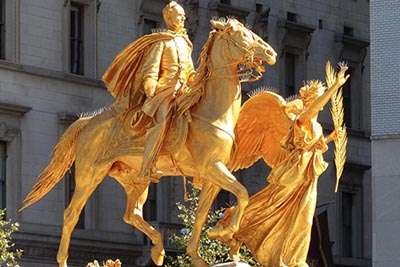It’s Thursday, January 1, 2026 in Austin, Texas
Fonts and Typography on Modern Websites
"Browser text" -- or text that is rendered by the browser has always proved challenging for web designers. The advantage of using browser text is that it is editable, easily changed, searchable and readable by search engines web bots like Google. It can be automatically enlarged using different browser settings, and style changes can be made site wide relatively easily and quickly by altering CSS cascading styles sheets.
The main disadvantage of browser based text has always been that one was effectively limited to using standard universally available web fonts like Arial, Verdana, Georgia -- as the fonts used on a website also had to be already installed on the end user's machine to see the website properly as the designer intended. The creative, fanciful fonts that web designers would often like to use for headlines or titles were generally not widely distributed among most web users. Thus web designers would generally use "browser text" for the body of articles, and use graphics for headlines and navigational elements. The problem with graphic image headlines is that they are not readable or searchable by search engine web bots. They must be changed manually in a program like Photoshop, and they aren't easily or quickly altered.
Modern browsers have incorporated various methods for actually embedding font files into websites, and the actual font is downloaded with the web page files and images. There have been many issues to overcome here as different browsers use different font file formats. Additionally, fonts used on websites required a special paid license to allow downloading and use of the font by web visitors -- whereas, fonts used in graphic files only required a license for the designer who actually created the original graphic (as the actual font file did not need to be downloaded to view the graphic). Most typography companies have added an additional add-on license fee to allow certain select fonts to be embedded on websites.
There has been a recent movement to make the embedding of fonts on websites quicker, easier, and less expensive for website creators. This allows web designers to create more visually attractive websites with dynamic and easily updated content.
Google has attempted to improve typography options for designers by providing a growing selection of free open source licensed fonts:
http://www.google.com/webfonts
They actually provide a Web Fonts API which hosts and loads the fonts off their super fast servers.
Typekit is another company that has tried to make it easy to add a wide variety of fonts to a website at a nominal price.
http://typekit.com
Typekit currently has pre-licensed approximately 600+ fonts for use on websites. They host the fonts for you and you select and save the fonts you want to use into kits. The annual price ranges from free to $99.99 for sites like e-commerce that require the ability to serve fonts over SSL connections.
Both sites mentioned above have tried to make it as easy as possible to create and use attractive, interesting fonts on your website.
P.S. One should keep in mind not to use too many downloaded fonts on a single page, as this could slow page load times. It would be advisable to only use 1 or 2 of these fonts on any one page.

AUSTIN
the most beautiful
My Top Ten Most Beautiful Pictures of Austin
I have spent years looking at pictures of Austin - and these are my favorites - the most outrageous beauties! I have added some comments about colors and life in Austin.

TECH ADVICE
stop them once and for all
How to End Annoying Robocalls - OMG a Solution!
Get rid of Robocalls. There is a free solution that really works - it's called Nomorobo and we love it.

WEB DESIGN
big breakthrough in color research
Want to Use the Viking Color Palette in Your Website?
Scientists have discovered the favorite Viking colors and now you can use them in your website!

WEB DESIGN
be prepared - choose wisely
Checklist for Law Firms Looking for a Web Designer
Here are some helpful hints and direction on the skills and knowledge your web designer should have.

WEB DESIGN
essentials for success
New Home Builder Website Checklist
Here's a list of the essentials you'll need to create your new home builder website. It's a list of all of the building blocks you'll need to make your site a success.

WEB DESIGN
max speed
7 Tips to Speed Up Your Website
Optimizing the speed that your website's content loads - will inevitably increase customer satisfaction, keep them on your website, reducing its bounce rate, and hopefully make them return visitors.

AUSTIN
save as many as you can!
Top 10 Reasons NOT to Move To Austin
With Austin making headlines and ending up on virtually every "Top 10 Best City for..." lists -- we now have about 150 people moving here daily!! We figured we should warn potential new residents of the hidden dangers of moving to Austin.

ANCESTRY RESEARCH
Howdy Grandmother!
Pocahontas ancestry and DNA - Sullivan Family Connection
How I discovered my ancestor Pocahontas and her Sullivan family descendants of Northern Virginia using the web - a genealogy posting by Bob Atchison.

Anonymous Love Letters - $500
Did you know that really was a profession? In 1961 you got paid $500 per letter, that would be $4100 today!

SEO Tips for Home Builders
When we build a new website for our home builder clients, we always try to focus on implementing "best practices search engine optimization (SEO)" to maximize their placement in organic search engine results.

GEDmatch Used to Snare Golden Gate Killer - Hackers Get MyHeritage Data
As you have probably read it has been extensively reported that Golden Gate Killer was found using data from GEDmatch. It's an amazing story.

Keller Williams Real Estate Agent Website Created
Pallasart launches new real estate website for Matthew Church, an Austin Keller Williams Associate. The site has many cool features that will help Matthew offer his services and attract new customers.

Hummingbird Farms Upgrades Images on their Website
Hummingbird Farms, the famous maker of body lotions seen on QVC , upgrades website with huge new product images, which increases sales

Top Texas Home Builder Redesigns Website
Olson Defendorf, the top award-winning Texas custom home builder, creates a new brand image and redesigns website. Click here to see what they just did in 2018.

The Best Antique Roses for Your Austin Garden
Here's a list of the best antique and old roses for your Austin garden plus a few recommended David Austin Roses

Maine Resort Redesigns Website
The Moorings in New Harbor did a total redesign of its website and added an availability and booking system.

My Favorite Semi-Precious Stones for Hardstone Animals
Here are some images showing my favorite semi-precious stone animals with jeweled eyes from my collection and stories of the stones and where they come from.

Why do my website fonts and photos look blurry in Windows 10?
When users install or upgrade to Windows 10, "display scaling" may be turned on "by default" to either 125% or 150% resulting in blurriness when viewing websites or applications on certain monitors.

5 Common Website Mistakes to Avoid Making
We've been in the web design business since 1996, and have seen many small businesses make these easily avoidable but often costly mistakes with their websites.

Should You Use Live Chat in Your Website?
Here's an informal overview of live chat options, outlining how Olark, one of the leading providers, works and its features. We explain how live chat can increase online sales and generate leads no matter the size of your company.

Where to Find and Buy Old, Antique and David Austin Roses Online
Bob Atchison's guide to find rare, antique and cabbagey roses to order online. Here you'll find the best sources with roses I especially love and recommend for your garden.

How to Add MLS Listings to Your Real Estate Website
If you are a realtor or real estate broker, you need a website to advertise your business and attract new clients. Get clients to stay on your website by providing access to Multiple Listing Service (MLS) real estate listings.

New Real Estate Web-Tools Just Released
Now it's possible to have a website that surpasses the very best in real estate. You can get an incredible design with powerful databases that can do anything and everything you could dream of...

Overcoming Your UNNATURAL FEAR of Cursive Fonts
The unspoken fear all web designers dread - you've been asked to use cursive fonts! There is no escape... yes, it has happened to me, Bob Atchison, many times and I have the battle scars to prove it. Here are some cursive fonts I actually like.

Should You Use WordPress for Your Website?
We get asked this question all the time... Should I use WordPress? Here are some of the top considerations to examine when deciding if WordPress is the right choice for building your website.

Drone Photography for Home Builder Websites
As homes in Austin, Texas are getting more expensive and selling for well over $1 million, many home builders and real estate agents are turning to aerial drone photography and videos to showcase their listings.

Is Scotty Bowers Telling the Truth About Hepburn and Tracy?
Is Scotty Bowers, the famous Hollywood pimp telling the truth about Spencer Tracy and Katharine Hepburn being gay? Here's a confirming story...


 New Home Builder Website Checklist
New Home Builder Website Checklist 












